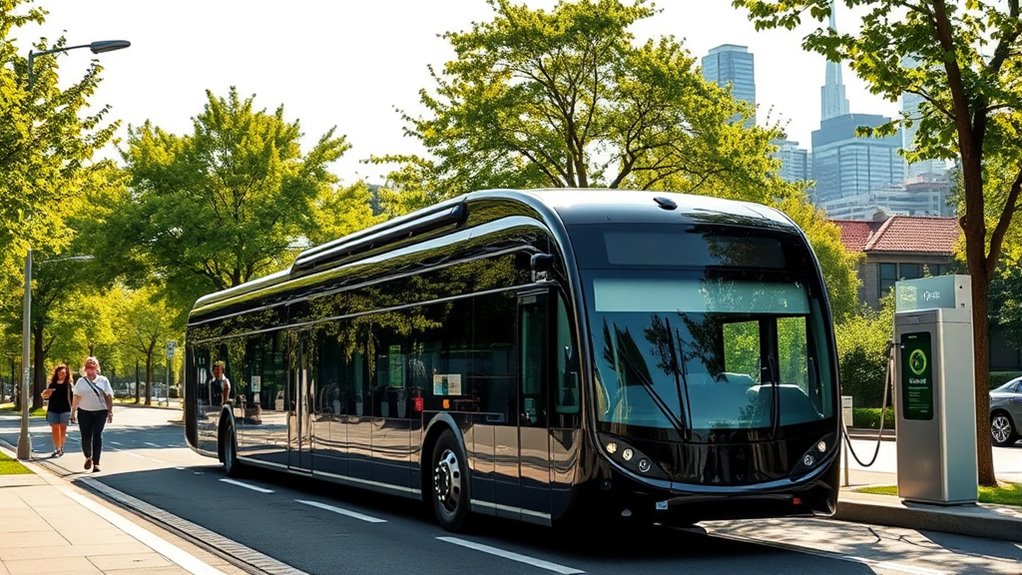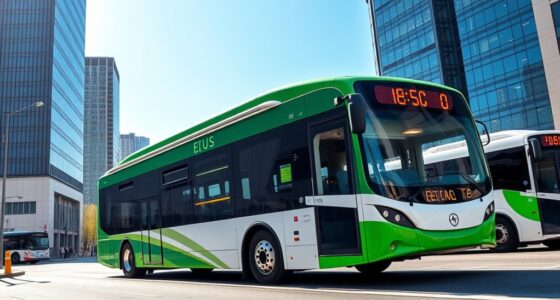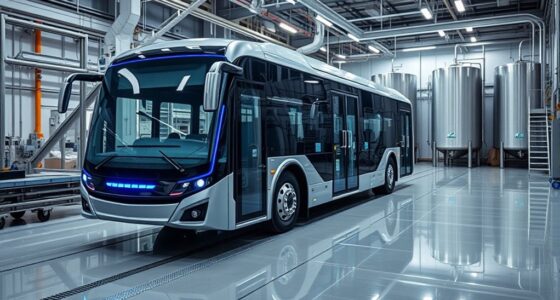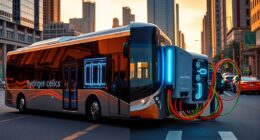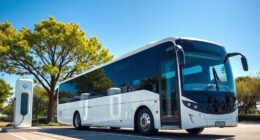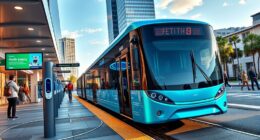To promote sustainable practices in electric bus operations, focus on integrating innovative charging technologies like wireless and rapid charging stations, which reduce downtime and energy waste. Use smart grid systems and vehicle-to-grid capabilities to optimize energy use and support the grid. Incorporate eco-friendly infrastructure such as solar-powered charging stations and electrified depots. Regular environmental assessments, efficient maintenance, and embracing advances in battery technology help boost longevity and reduce environmental impacts. Continuing will reveal more strategies to maximize sustainability.
Key Takeaways
- Implement wireless and rapid charging technologies to minimize downtime and optimize energy efficiency during operations.
- Incorporate renewable energy sources, such as solar-powered charging stations, to reduce carbon footprint.
- Use smart grid integration and vehicle-to-grid systems to balance energy demand and supply effectively.
- Adopt regular environmental impact assessments to identify and improve sustainability practices continuously.
- Maintain electrified depots and advanced battery systems to enhance operational efficiency and extend vehicle lifespan.

As cities seek to reduce their environmental footprint, electric buses have emerged as a sustainable transportation solution. These buses offer significant environmental benefits, including drastically lowering greenhouse gas emissions compared to traditional diesel models. By switching to electric, you help eliminate air pollutants like particulate matter and nitrogen oxides, which directly impact urban air quality and public health. Additionally, electric buses generate less noise, creating a more comfortable and peaceful environment for city residents. Their use of electricity from renewable sources further diminishes reliance on fossil fuels, supporting global efforts to combat climate change. When powered by renewable energy, electric buses can even achieve carbon neutrality, making them a truly sustainable choice for urban transportation.
To maximize their efficiency, innovative charging technologies are transforming electric bus operations. Wireless charging, using inductive technology, allows buses to recharge seamlessly at bus stops without stopping for long periods. Rapid charging stations strategically located along routes enable quick top-ups, reducing downtime and keeping buses on schedule. Some systems incorporate solar panels into charging stations, harnessing clean energy and lowering dependence on non-renewable sources. Vehicle-to-grid (V2G) technology takes this a step further by enabling buses to feed excess energy back into the grid during off-peak hours, helping balance energy demand and supply. Smart grid integration ensures that these energy flows are managed efficiently, optimizing the overall system and reducing waste. Renewable energy integration can further enhance the sustainability of electric bus systems by ensuring that the electricity used is environmentally friendly. Incorporating wall organization systems in depot facilities can further streamline maintenance and operational workflows, enhancing overall sustainability. Moreover, understanding the shelf life of electric vehicle components is essential for maintaining long-term operational sustainability and minimizing waste. Regular environmental impact assessments also help identify potential areas for improvement, ensuring ongoing progress toward sustainability goals.
Operational sustainability depends on careful planning and strategic investments. You should focus on resource utilization to guarantee maximum efficiency, from scheduling to energy management. Governments and industry stakeholders play an essential role by providing regulatory support, streamlining permits, and encouraging the adoption of electric buses through incentives. Investing in infrastructure, such as electrified bus depots and energy storage solutions, is vital to support a growing fleet. Additionally, advancements in battery technology continue to improve the lifespan and performance of electric buses, contributing to operational efficiency. Regular environmental impact assessments help monitor progress and identify opportunities for improvement, guaranteeing that operations remain aligned with sustainability goals. Technical assistance and collaboration foster innovation and facilitate the transition, making sure that electric buses operate reliably while minimizing environmental impacts.
Economically, electric buses offer long-term savings through lower maintenance and energy costs. Government incentives, grants, and subsidies help offset initial investment costs, making adoption more accessible. Moving to electric can also create new jobs in manufacturing, infrastructure development, and maintenance sectors, boosting local economies. Over time, reduced fuel expenses and maintenance requirements translate into significant financial benefits for transit agencies and cities alike.
On a global scale, initiatives like India’s PM-eBus Sewa and European urban sustainability programs demonstrate a collective commitment to expanding electric bus deployment. These efforts, supported by international cooperation and innovative policies, aim to achieve ambitious decarbonization and climate targets, illustrating how sustainable practices in electric bus operations contribute to a cleaner, healthier future for urban environments.
Frequently Asked Questions
How Do Electric Buses Perform in Extreme Weather Conditions?
You’ll find that electric buses handle extreme weather well. In cold conditions, pre-heating batteries and even weight distribution improve traction and range.
During hot weather, thermal management systems prevent overheating, and route adjustments help conserve energy.
Overall, you’ll notice smoother rides, better handling, and fewer maintenance issues, thanks to fewer weather-sensitive parts.
These features make electric buses reliable and efficient, no matter the temperature outside.
What Are the Long-Term Cost Savings of Electric Bus Fleets?
You’re curious about the long-term cost savings of electric bus fleets. Over time, you’ll notice significant savings on fuel and maintenance—up to $400,000 and $125,000 respectively.
Although the initial purchase costs are higher, the lower operating expenses and potential revenue from vehicle-to-grid capabilities make electric buses more economical overall.
Implementing financing and utility incentives can further enhance these savings, making electric buses a smart long-term investment for your fleet.
How Is Passenger Comfort Maintained With Quieter Electric Buses?
Imagine your ride as a gentle stream, where quietness soothes and comforts. With electric buses, you notice less engine noise and vibrations, making your journey smoother and more peaceful.
Features like noise-insulating materials, optimized gear designs, and vibration dampers work together to create a serene environment. You’ll find clearer announcements, fewer start-stop jerks, and a calmer cabin, all enhancing your overall comfort and making each trip feel like a tranquil passage.
What Are the Challenges in Integrating Renewable Energy Sources?
When you consider integrating renewable energy sources, you face several challenges. You need to expand grid capacity to handle increased demand and guarantee stable power supply.
You also must manage the variability of renewable sources like solar and wind, which may require energy storage solutions.
Additionally, integrating these sources seamlessly into existing infrastructure demands careful planning, investment, and upgrades, making the shift complex but essential for sustainable energy use.
How Do Electric Bus Charging Schedules Impact Grid Stability?
Did you know that managing electric bus charging during off-peak hours can reduce grid strain by up to 30%? Your charging schedule directly impacts grid stability by optimizing demand, especially during high-usage times.
Smart charging shifts energy use, preventing overloads and supporting reliable operations. By controlling when buses charge, you help balance supply and demand, making the entire grid more resilient and efficient for everyone.
Conclusion
By adopting these sustainable practices, you’re not just improving electric bus operations—you’re transforming the future of transportation itself. Your efforts can slash emissions so drastically that you’ll single-handedly turn cities into pristine, breathing lungs of the planet. Imagine leading a revolution so powerful, it reshapes the world’s environmental destiny, all from your commitment to green innovation. Truly, your actions have the potential to make history and set a new standard for global sustainability.
